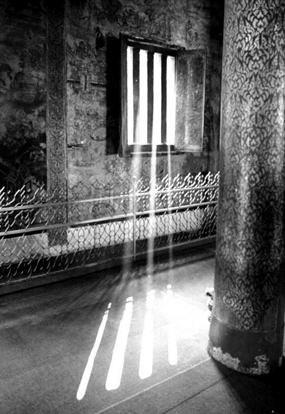A photographic friend of mine mentioned that he had been taking some shots in one of the wats down Sattahip way, and how he enjoyed the creativity that the temples brought out in him.
In Thailand we are surrounded by temples (wats). At last count there were 70,000 of them, and undoubtedly there’s more. However, when something becomes commonplace, we begin not to see them.

Our wats are classic examples. We have seen so many, we don’t see them any more, yet the first time tourists to Thailand go mad when they see the temples, even though for many it is only the larger temples in Bangkok. There are many more, and more accessible for photography as well.
Thailand is actually a photographer’s paradise. Light levels are strong, shadows are strong and images are also strong if you use light and shadow to your advantage.
Here is how to take that great wat shot – only it isn’t one shot. It is impossible to show a wat with one snap. One of the reasons for this is the fact that a wat is a microcosm of Thai society. People eat there, live there, learn there and end up there for their funerals. So in actual fact you are trying to show not only the grandeur of the architecture, but the fact that the wat has its own life going on within its boundaries.
Here is how I would approach the subject, and remember we are looking for production quality shots here. The preparation is to go there the day before your shooting day to see how the sun shines on the buildings. To get the textures and colors you need the sun striking the walls at an angle. Full shade or full sun is not the way. It’s back to using light and shadow to show form. You will have to note what are the best times of day to record the various architectural details. Also be prepared to use a close up shot or two to highlight some of the small details. By the way, always remember that a wat is a place of religious worship and significance, so do take your shoes off and be respectful.
Wats are inhabited by much more than the saffron robed monks. There are teachers, nuns, novitiates, school children, street vendors and even tourists. A very mixed bag. Try to take shots to show just why these people are there in the wat and its compound. This is where a “long lens” (135 mm upwards) can be a help. You can get the image you want without having to intrude into the person’s personal space. However, remember that if there is any doubt as to whether your subject would really want that photo taken – then ask permission first. It is my experience that the vast majority of people will happily respond positively to your request. Even when there is no common language, a smile and a wave of the camera in their direction and an “OK?” is generally all that is necessary.
Taking pictures inside the wat is not as easy as the exterior shots. The light levels are very low and there is often the feeling that you are intruding in someone else’s religious practices. Taking a flash photograph really is an intrusion in my view. This is where the tripod is great. Set the camera up on the tripod, compose the shot, set it on Time Exposure and quietly get that shot of a lifetime. You will probably need around 5-10 seconds at f5.6, but that is just a guide and you should experiment. If you set the camera on Auto mode and turn off the flash you will get better results.
By now you should have taken almost one complete day on your local wat. Verticals, horizontals, close-ups and wide angle shots. Do not be afraid to shoot plenty of images. It is the only way to improve and the only way to get great shots. With digital technology you can take as many variations of one shot as you want, always remember that. Just avoid taking the ‘same’ shot four times – one vertical and one horizontal for each subject, but that is all.




